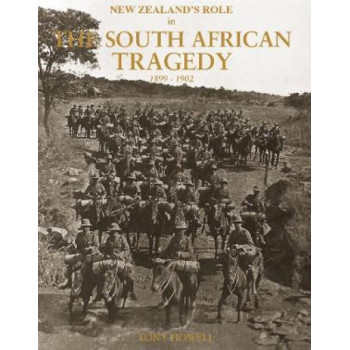The South African Tragedy 1899-1902: New Zealand's Role
- Author: Howell, Tony
- ISBN: 9780994132376
- Availability:
$NZ 87.99
Ex Tax: $NZ 87.99
At 5.00 pm on 11 October 1899 the unthinkable happened - the Boer Presidents of the South African Republic (Transvaal) and Orange Free State declared war on Great Britain, arguably the world's super-power at that time. The war was not expected to last long once the infantry based British 1st Army Corps landed in South Africa. General Sir Redvers Buller VC would teach the Boers a lesson and then return triumphant. History shows that the war lasted 960 days and the Boers taught the British a few lessons during that time.
The Boers laid siege to Ladysmith, Kimberley and Mafeking and advanced into Natal, the Cape Midlands and Western Cape. Buller's Army Corps was shipped from Britain and suffered three disastrous defeats over 10-17 December 1899, which the British media dubbed 'Black Week'. During the battles of Stormberg, Magersfontein and Colenso, the British lost 2,776 soldiers killed, wounded or captured. Defeat at Spionkop on 24 January 1900 added another 1,185 casualties to that list. Following the Black Week defeats, Buller was replaced as Commander-in-Chief by Field Marshal Lord Frederick Roberts VC.
Roberts brought massive reinforcements with him and began to convert a large percentage of his infantry army to mounted infantry. On 23 November 1899, the First New Zealand Mounted Rifles (1 NZMR) contingent arrived and other colonial mounted contingents followed. This was the first and last war to use horse mounted infantry on such a large scale. Robert's daring plan sent Lieutenant-General French's Cavalry Division to out-flank Boer General Cronje's position at Magersfontein resulting in the relief of Kimberly on 15 February 1900 and the subsequent capture of Cronje and his 4,000 Boers. 1 NZMR were possibly the first to enter Kimberley. From that point on the war turned in Britain's favour.Robert's cavalry, mounted infantry and infantry divisions next captured Bloemfontein, Johannesburg and then Pretoria. Mafeking was relieved and Buller finally chased the Boers out of Natal. With Pretoria captured on 5 June 1900, the war should have finished. Roberts returned to Britain and a hero's welcome. Lord Herbert Kitchener replaced Roberts but, the Boers would not surrender. The guerrilla phase of the war actually began soon after the capture of Bloemfontein, lasting an additional 726 days.
Tony's descriptions of the various battles, triumphs, defeats and blunders are easy to understand. He uses his extensive army experience to explain the relevance of actions and the British and Boers use of strategies and tactics. The reader gets a clear insight into the use of the scorched earth policy, concentration camps, blockhouses, massive sweeps and the tragic effect on Boer families and the African people. The Boer commando tactics are also explained. Tony has recorded 50 significant battles many of which involved the New Zealand's Mounted Rifles.
The New Zealand contribution of 6,500 men in ten contingents is covered in detail, as are many of the social issues such as Maori participation in the war. Today, we can look back with pride at how incredibly supportive the 800,000 population of New Zealand was of these brave soldiers. About 81,000 or more persons died during the war. In total, 70 NZMR soldiers died as a result of battle while 158 died from illness, disease or accident and 166 were wounded. The NZMR soldiers served our nation with pride, winning many accolades for their skill, daring and professionalism. The Times History of the war in South Africa acknowledges that "the New Zealanders were on average the best mounted troops in South Africa"

